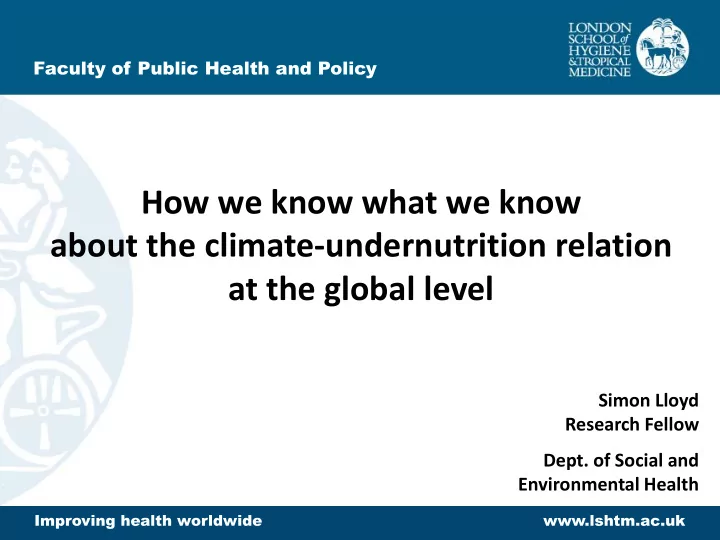

Faculty of Public Health and Policy How we know what we know about the climate-undernutrition relation at the global level Simon Lloyd Research Fellow Dept. of Social and Environmental Health Improving health worldwide www.lshtm.ac.uk
Outline • Briefly: Food security and undernutrition at present Climate/weather-undernutrition relation • General modelling strategy used: Advantages Drawbacks (from the perspective of health) • Draw some general conclusions about future directions
Food security & undernutrition • FAO 2012 : 870 million people chronically undernourished • 165 million children stunted • 35% of mortality in under 5s Sources: FAO 2012; Black 2013; UN 2012
Source: IFPRI, 2012
Climate change - undernutrition • Via lens of crop productivity… …which has an intuitive relation to undernutrition Source: IPCC, 2007
By the end of the century: In the tropics and sub-tropics , >90% prob that growing season temps will exceed the most extreme seasonal temps over 1900 to 2006. In temperate regions, hottest seasons on record will represent the future norm (in many locations) Source: Battisti & Naylor, 2009, Science
How do we know what we know… ...about future undernutrition under climate change? • 12 modelling papers over last 20 years • regardless of scenarios or specific outcome, all found climate change likely to increase hunger/undernutrition • undernourishment may increase 5-25% globally • stunting may increase (relatively) 23% in parts of Africa • All use the same general strategy Sources: Schmidhuber & Tubiello 2007; Lloyd et al 2011
How do we model it? Probability density function - dietary energy consumption P(U) 0 1000 2000 3000 4000 5000 6000 energy (kcal)
Advantages of strategy • Detailed attention to: • climate under given emissions • climate-crop relation for major crops • movement of food via global market • national food availability and undernutrition i.e. intuitive aspects • Global level focus • Quantifies impacts • Facilitates multi-disciplinary work • Readily incorporates improved models and new scenarios
Drawbacks of strategy 1 Not a property of the strategy itself... ... rather that it is the only strategy that has been used.
Drawbacks of strategy 2 Flipside of benefit of quantification: To quantify, need data. To make projections, need data for present and future. If no data, factor necessarily left out, no matter how important it may be.
Undernutrition: causes Changing prevalence: 1970 to 1995, reduction in child underweight attributable to: • 43%, improved female education • 26%, increase food availability • 19%, improved water access (Smith and Haddad, 2000, IFPRI) Irreversible stunting at 24 months: • 25% (8-38%) due to having >=5 episodes of diarrhoea (Checkley et al, 2008, Int J Epi) Source: UNICEF, 1990
What do we have data for? Modelled pathway: climate to child
Drawbacks of strategy 3 Existing health models are static (i) Within system feedbacks e.g. • Individual level: undernutrition-diarrhoeal disease • Global level: cheap imports reducing viability of local production increasing dependence on cheap imports (ii) Structural change e.g. • Reduced viability of local production driving rural-urban migration, and, changing vulnerability to global food price fluctuations
Drawbacks of strategy 4 Enforced vantage point: crop productivity
Theories of undernutrition Assumptions regarding the role of increased food Assumptions regarding role of population growth production in alleviating hunger Non-Malthusian Neo-Malthusian ‘ Modernization ’ ‘ Productionist Neo-Malth ’ Hunger caused by lack of Hunger caused by food Productionist modernization and tech production falling behind population growth ‘Political Economy’ ‘ Ecological Neo-Malth ’ Hunger is caused by social Hunger is caused by Non-productionist inequality and poverty population growth and produced both locally AND environmental degradation globally Source: Buttel, F.H. 2000, Contemporary Sociology
Conclusions Develop alternative strategies... ... but how? • Model building as an ongoing process (Levins 1966) • Alternative explanatory programmes, heuristically (Abbott 2004) • Dynamics • Theories
Recommend
More recommend